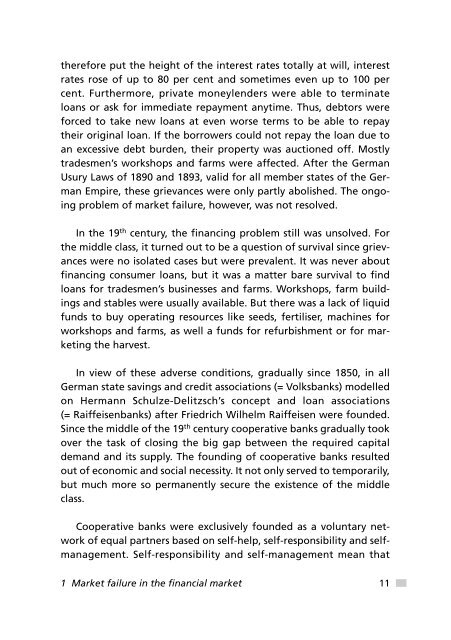Introduction - Genossenschaftsverband Bayern
Introduction - Genossenschaftsverband Bayern
Introduction - Genossenschaftsverband Bayern
You also want an ePaper? Increase the reach of your titles
YUMPU automatically turns print PDFs into web optimized ePapers that Google loves.
therefore put the height of the interest rates totally at will, interest<br />
rates rose of up to 80 per cent and sometimes even up to 100 per<br />
cent. Furthermore, private moneylenders were able to terminate<br />
loans or ask for immediate repayment anytime. Thus, debtors were<br />
forced to take new loans at even worse terms to be able to repay<br />
their original loan. If the borrowers could not repay the loan due to<br />
an excessive debt burden, their property was auctioned off. Mostly<br />
tradesmen’s workshops and farms were affected. After the German<br />
Usury Laws of 1890 and 1893, valid for all member states of the German<br />
Empire, these grievances were only partly abolished. The ongoing<br />
problem of market failure, however, was not resolved.<br />
In the 19 th century, the financing problem still was unsolved. For<br />
the middle class, it turned out to be a question of survival since grievances<br />
were no isolated cases but were prevalent. It was never about<br />
financing consumer loans, but it was a matter bare survival to find<br />
loans for tradesmen’s businesses and farms. Workshops, farm buildings<br />
and stables were usually available. But there was a lack of liquid<br />
funds to buy operating resources like seeds, fertiliser, machines for<br />
workshops and farms, as well a funds for refurbishment or for marketing<br />
the harvest.<br />
In view of these adverse conditions, gradually since 1850, in all<br />
German state savings and credit associations (= Volksbanks) modelled<br />
on Hermann Schulze-Delitzsch’s concept and loan associations<br />
(= Raiffeisenbanks) after Friedrich Wilhelm Raiffeisen were founded.<br />
Since the middle of the 19 th century cooperative banks gradually took<br />
over the task of closing the big gap between the required capital<br />
demand and its supply. The founding of cooperative banks resulted<br />
out of economic and social necessity. It not only served to temporarily,<br />
but much more so permanently secure the existence of the middle<br />
class.<br />
Cooperative banks were exclusively founded as a voluntary network<br />
of equal partners based on self-help, self-responsibility and selfmanagement.<br />
Self-responsibility and self-management mean that<br />
1 Market failure in the financial market<br />
11
















